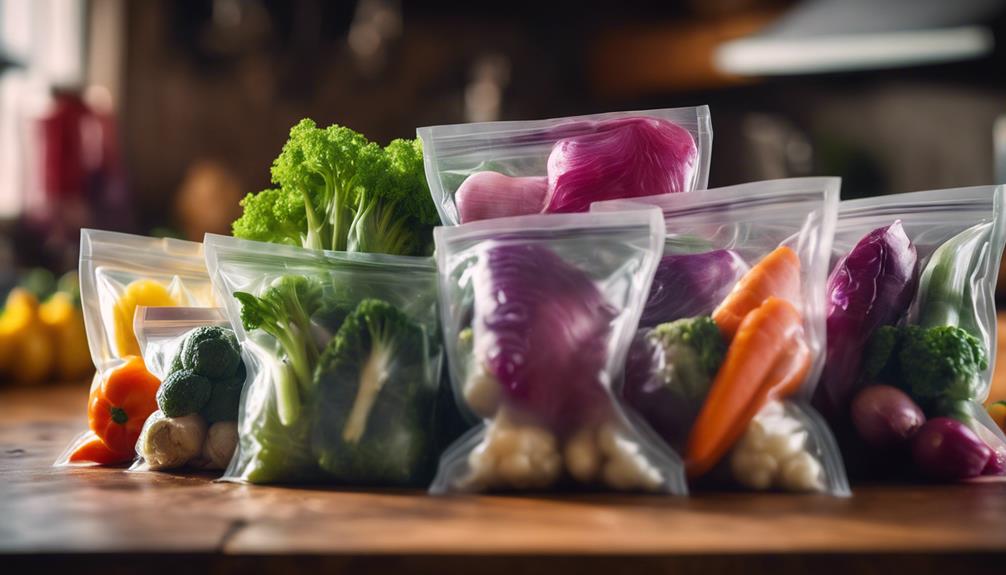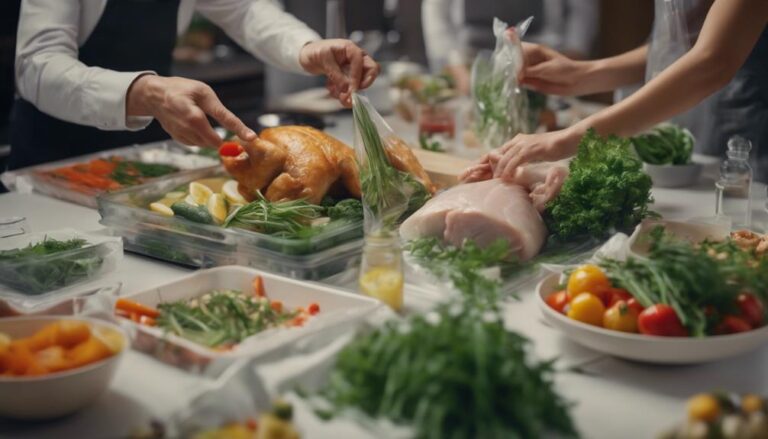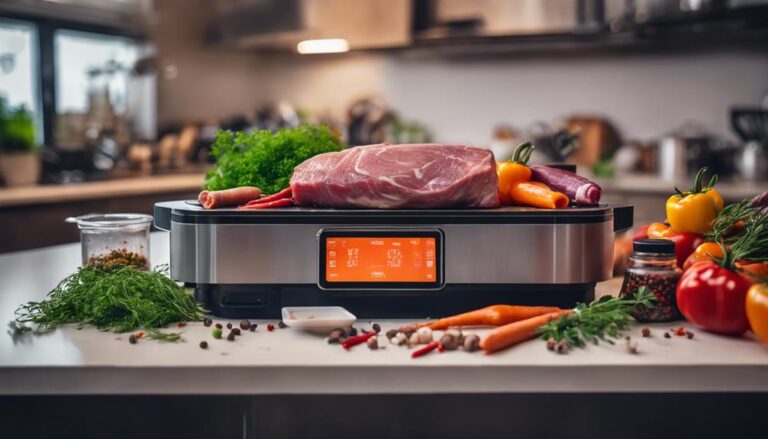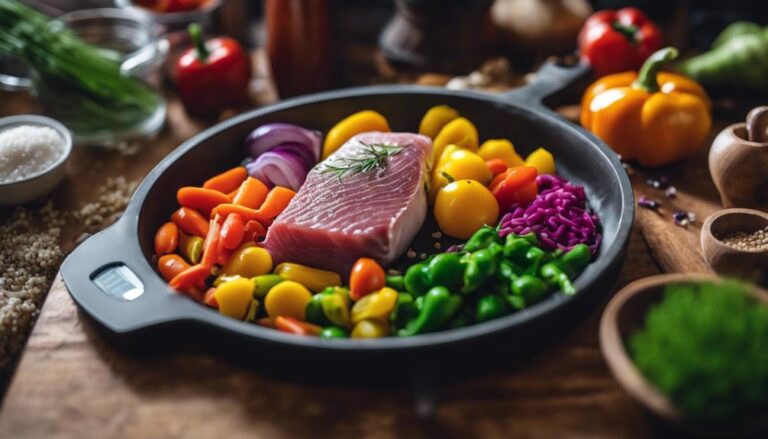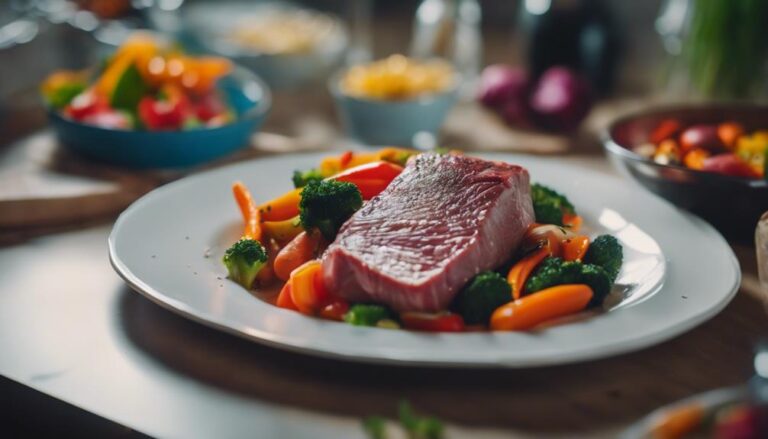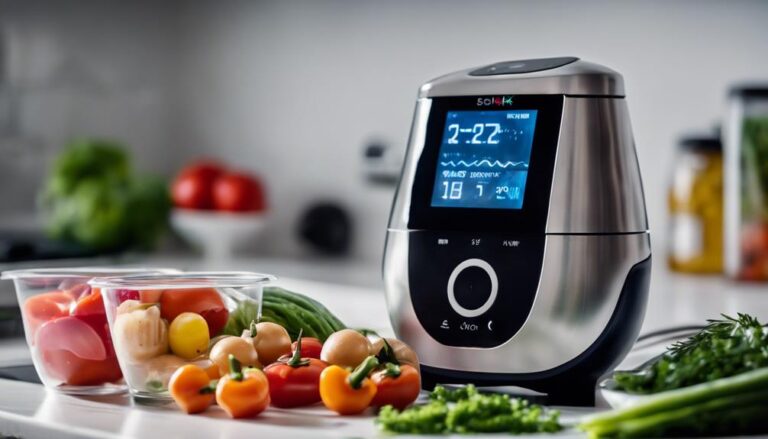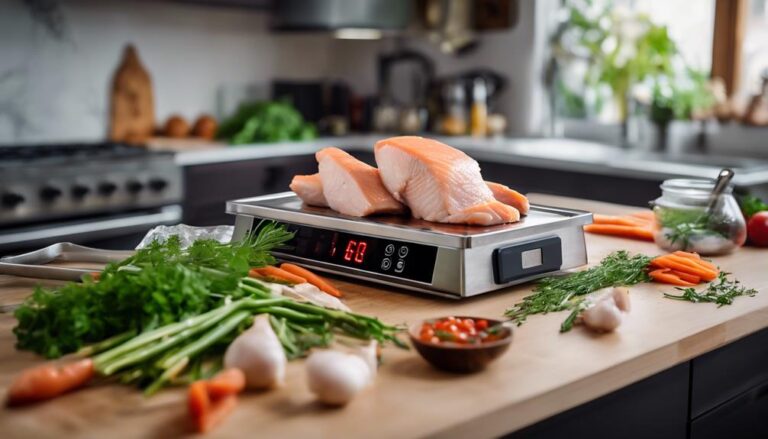How to Achieve Perfectly Tender Sous Vide Vegetables
To achieve perfectly tender sous vide vegetables, start by selecting the right temperature and cooking time for each type. Generally, green vegetables cook best at about 183°F for 10-15 minutes, while root vegetables need higher temperatures for longer, around 185°F to 190°F for 60-90 minutes. Cut your veggies into uniform sizes for even cooking and season them with herbs or fats before vacuum sealing. This technique retains moisture and flavor. Always preheat your water bath, and if you plan to cook meat, stagger cooking times for ideal results. You'll discover more tips for enhancing flavor and texture along the way.
What You Will Learn Here
- Use precise temperature control between 180°F to 198°F for perfectly tender vegetables without overcooking.
- Vacuum seal vegetables to retain moisture, flavor, and ensure even cooking.
- Cut vegetables into uniform sizes for consistent cooking and optimal texture.
- Adjust cooking times and temperatures based on vegetable type for desired tenderness.
Understanding Sous Vide Cooking
Sous vide cooking immerses your vegetables in a precisely controlled water bath, ensuring they achieve perfect tenderness without the risk of overcooking. This method allows you to cook at specific temperatures, typically ranging from 180°F to 198°F, which is vital for achieving the best texture.
For instance, if you want to cook carrots, setting the temperature to around 185°F for 45 to 60 minutes will yield tender yet firm results.
Using a vacuum seal bag is important in sous vide cooking, as it allows for even cooking while retaining moisture and flavor. When you seal your vegetables, you're locking in their natural juices, which enhances their taste.
Different vegetables break down at specific temperatures; understanding this can help you select the right settings for each type. Pectin and starch, for example, require careful temperature control to reach the desired tenderness.
Benefits of Sous Vide for Vegetables
Cooking vegetables using the sous vide method consistently preserves their flavors and nutrients, making your meals healthier and more delicious. This technique allows you to create perfectly cooked sous vide vegetables that are tender but still maintain their structure.
By cooking at precise temperatures, you're effectively preventing overcooking and nutrient loss, ensuring each bite is as nutritious as it's tasty.
Here are some benefits of using sous vide for your vegetables:
- Enhance natural sweetness: Sous vide cooking brings out the inherent flavors of your vegetables, making them more enjoyable to serve.
- Consistent results: This method guarantees that you'll achieve the same quality every time, reducing the guesswork in preparation.
Incorporating sous vide into your cooking routine not only elevates the quality of your meals but also saves you time on preparation.
Whether you're hosting a dinner party or cooking for your family, sous vide vegetables can truly impress your guests while maintaining their health benefits.
Ideal Time and Temperature

To achieve perfectly tender sous vide vegetables, it's important to understand the ideal time and temperature for each type. Using the right cooking temperature and time guarantees that your vegetables reach that desired crisp tender texture or fork-tender results. Here's a quick reference table to help you:
| Vegetable Type | Cooking Temperature | Cooking Time |
|---|---|---|
| Green Vegetables | 183°F (84°C) | 10-15 minutes |
| Root Vegetables | 185°F (85°C) | 45-60 minutes |
| Starchy Vegetables | 194°F (90°C) | 45-60 minutes |
| Root Vegetables (Fork-Tender) | 190°F (88°C) | 60-90 minutes |
| Green Vegetables (More Tender) | 185°F (85°C) | 15-25 minutes |
When cooking sous vide vegetables, remember that longer cooking times at the appropriate temperature lead to more tender vegetables. For starchy vegetables, cooking at 194°F (90°C) for 45 to 60 minutes will yield an ideal creamy texture while maintaining their flavors. By following these guidelines, you can serve your guests perfectly tender sous vide vegetables they'll love.
Preparing Vegetables for Sous Vide
Before getting started, make certain to wash and peel your vegetables to remove dirt and contaminants for a clean sous vide experience. Proper preparation is key to achieving perfectly tender sous vide vegetables that your guests will love.
Here's how to prepare them effectively:
- Cut vegetables into uniform sizes to guarantee even cooking and a consistent texture throughout your dish.
- Season the vegetables with herbs, spices, or fats like butter to enhance their flavor during the cooking process.
Once your vegetables are ready, don't forget to preheat the sous vide water bath to the recommended temperature, typically between 183°F and 190°F. This step is essential for securing ideal tenderness and texture.
Cooking Specific Vegetables
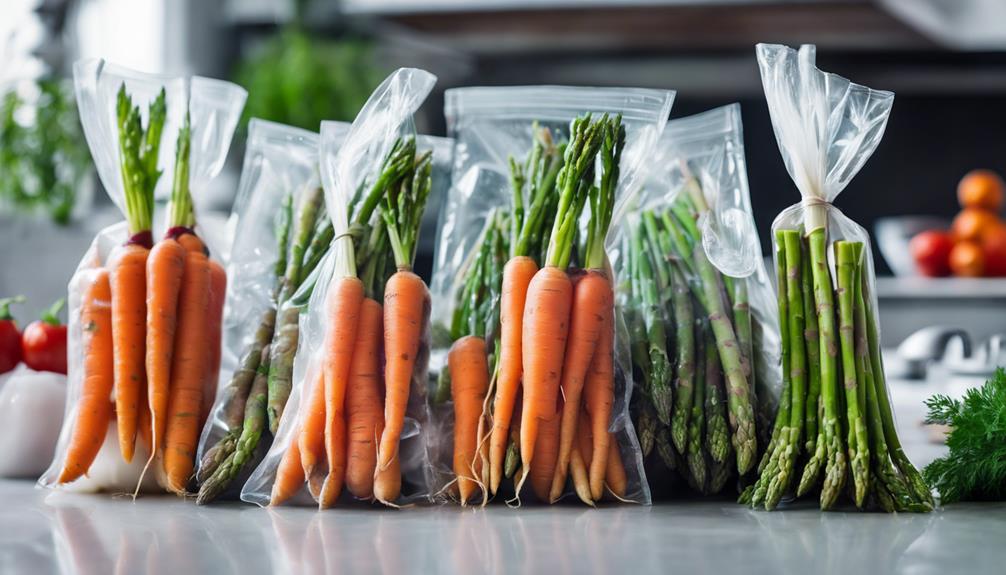
Achieving the perfect texture for sous vide vegetables requires attention to specific cooking times and temperatures tailored to each type of vegetable.
For sous vide carrots, set your water bath to 185°F and cook them for 45-60 minutes. Adding butter and brown sugar in your sous vide bags can enhance their flavor, making them a delightful side dish.
When it comes to sous vide green beans, cook them at 183°F for a crisp tenderness or at 185°F for a more tender texture. For root vegetables like potatoes, a higher temperature range of 185°F to 190°F guarantees they become fork-tender, perfect for creating sous vide mashed potatoes.
Remember that uniform-sized vegetables are essential for consistent cooking. Cooking times can vary considerably based on size and type, so cut your vegetables accordingly.
Apples and other fruits can be cooked at 183°F to enhance their natural sweetness while keeping them perfectly tender.
Simultaneous Cooking With Meat
Cooking vegetables and meat simultaneously in a sous vide setup allows you to enjoy perfectly tender veggies alongside your favorite protein without compromising on texture or flavor. To achieve this, you'll want to plan your cooking times and temperatures carefully.
Start by sous vide cooking the vegetables at their required temperature, typically between 183°F to 190°F. Once the vegetables are done, you can then reheat them while the meat finishes cooking at its lower temperature. For instance, cook carrots for 45-60 minutes at 185°F, guaranteeing they maintain their ideal texture.
Using a sous vide machine makes this process seamless. By preheating the water bath to the appropriate temperature for your vegetables before adding them, you minimize wait time, making your meal preparation efficient.
Remember, the key is to stagger the cooking times to ascertain both your vegetables and meat come out perfectly. This method guarantees that your guests enjoy a delightful combination of flavors and textures.
Essential Sous Vide Vegetable Recipes
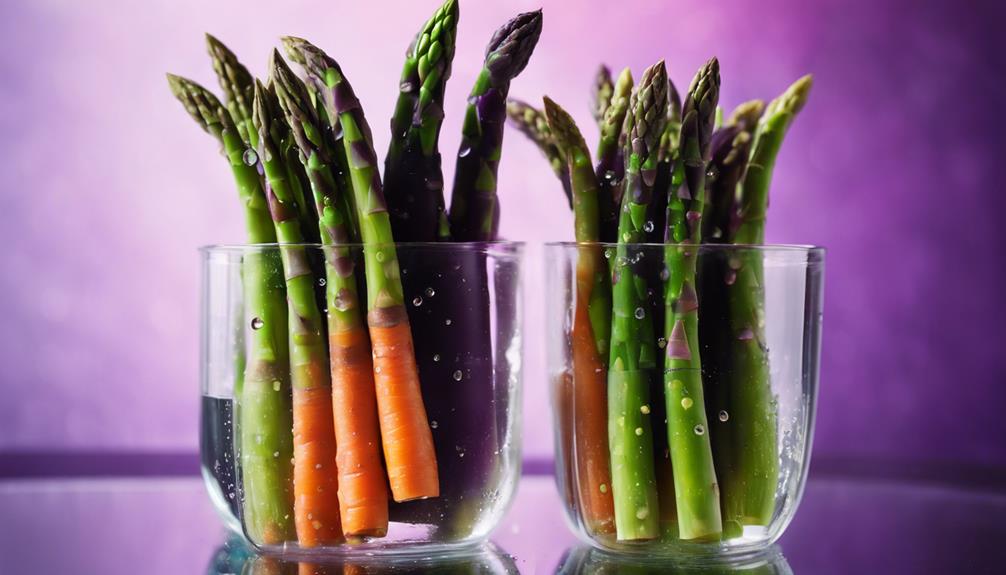
Explore five essential sous vide vegetable recipes that will elevate your home cooking with perfectly tender and flavorful results. These sous vide recipes guarantee that the natural flavors of your vegetables shine through, making them ideal for serving as delicious sides.
| Vegetable | Cooking Temperature & Time |
|---|---|
| Sous Vide Asparagus | 185°F for 12 minutes |
| Sous Vide Beets | 185°F for 1-2 hours |
| Sous Vide Carrots | 185°F for 45-60 minutes |
For a simple yet impressive side, try sous vide asparagus cooked with lemon and butter for a delightful crunch. If you're in the mood for something sweet, sous vide carrots with brown sugar and butter create a rich glaze that pairs beautifully with any main dish. For a colorful addition, sous vide beets prepared for a zesty salad will not only maintain their vibrant color but also their natural sweetness. Each of these vegetable recipes will help you cook vegetables to perfection, guaranteeing they retain their nutrients and flavors. Just seal them in a sous vide bag, set your temperatures, and enjoy the tasty results!
Tips for Perfect Vegetables
To guarantee your sous vide vegetables turn out perfectly tender, pay attention to their size and cooking time for consistent results. Uniformly cut vegetables assure even cooking, preventing smaller pieces from overcooking while larger ones remain underdone.
The right temperature is key; cook root vegetables at 185°F for 45-60 minutes, while green vegetables only need 10-15 minutes at 183°F.
Here are some tips to enhance your sous vide experience:
- Use airtight bags: Seal your vegetables with a vacuum sealer or use the water displacement method to keep bags airtight. This prevents floating and guarantees even heat distribution.
- Infuse flavor: Add butter, herbs, or even a touch of sugar into the bags. This allows the cooking liquid to infuse flavor while retaining moisture.
Advanced Techniques and Tools
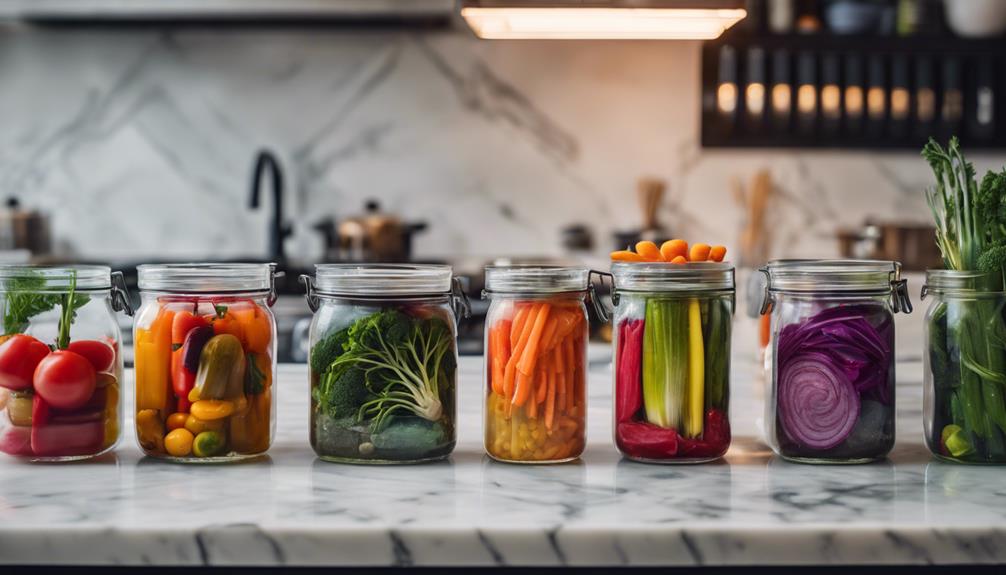
Utilizing advanced techniques and tools can elevate your sous vide vegetable game, guaranteeing precise cooking and enhanced flavors.
Start with a reliable immersion circulator, which maintains exact water temperatures between 183°F and 190°F for perfect results. When preparing your vegetables, opt for uniform-sized pieces to confirm even cooking. Cooking times vary, so cook carrots for about 45-60 minutes at 185°F to achieve tenderness without mushiness.
For sous vide cooking, use heavy-duty freezer bags or reusable silicone bags, confirming a proper seal to keep water out and minimize air exposure. This step is essential for maintaining flavor and texture.
Don't forget to enhance your vegetables with seasonings and fats like butter or even a touch of sugar. After cooking, consider caramelizing the cooking liquid for a rich glaze that adds depth to your dish.
To guarantee your bags remain submerged, use the water displacement method. This technique prevents floating and promotes even cooking throughout the entire batch.
Frequently Asked Questions
What Is the Best Temperature for Sous Vide Vegetables?
For sous vide vegetables, aim for 183°F to 190°F, adjusting based on vegetable varieties. This temperature range enhances texture, flavor infusion, and nutrient retention, ensuring your meal prep impresses everyone with perfectly seasoned results.
Can You Overcook Vegetables in Sous Vide?
Yes, you can overcook sous vide vegetables. Texture differences arise with prolonged cooking, affecting flavor enhancement. Adjust cooking times based on vegetable types, avoid common mistakes, and use seasoning techniques for better results and storage tips.
What Methods Are Good for Cooking Vegetables Crisp Tender?
For crisp-tender vegetables, try steaming techniques or roasting methods. Don't forget blanching benefits and grilling tips. Sautéing secrets and pressure cooking also work well, while microwave hacks and stir frying essentials can elevate your dishes beautifully.
How Do You Make Vegetables Tender?
To make vegetables tender, try steaming techniques, roasting methods, or blanching benefits. Enhance flavor with seasoning tips, herb pairings, and marinating ideas. Grilling options and sautéing styles also work wonders for delicious, tender results.
Conclusion
By mastering sous vide cooking, you can achieve perfectly tender vegetables every time.
Understanding the right time and temperature for different vegetables is key to enhancing their natural flavors.
Preparing them properly and using the right techniques will elevate your cooking.
Don't hesitate to experiment with simultaneous cooking alongside meat for a complete meal.
With practice, you'll create delicious, gourmet-quality vegetables that impress at any dining table.
Enjoy the benefits of this versatile cooking method!
